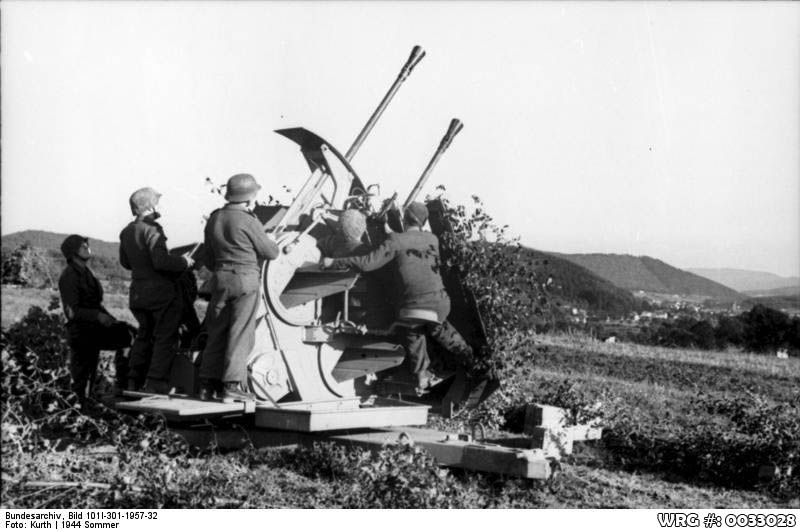 North France - 37mm Flak 43 in position on field, end of July - early September 1944.
North France - 37mm Flak 43 in position on field, end of July - early September 1944.[Source: Bundesarchiv, Bild 101I-301-1957-32 / Kurth / CC-BY-SA 3.0]
The 37mm Flak 18/36/37/43 was a series of anti-aircraft cannon produced by Nazi Germany that saw widespread service in the Second World War. The cannon was fully automatic and effective against aircraft flying at altitudes up to 4,200 m. The cannon was produced in both towed and self-propelled versions. Having a flexible doctrine, the Germans used their anti-aircraft pieces in ground support roles as well; 37 mm guns were no exception to that.
Development:
The original 37 mm gun was developed by Rheinmetall in 1935 as the 3.7 cm Flak 18. It had a barrel length of 57 calibers (hence the additional designation L/57), which allowed 4,800 m (15,700 ft) maximum ceiling. The armour penetration was considerable when using dedicated ammunition, at 100 m distance it could penetrate 36 mm of a 60°-sloped armour, and at 800 m distance correspondingly 24 mm. It used a mechanical bolt for automatic fire, featuring a practical rate of fire of about 80 rounds per minute (rpm). The gun, when emplaced for combat, weighed 1,750 kg (3,860 lb), and complete for transport, including the wheeled mount, 3,560 kg (7,850 lb).
The Flak 18 was only produced in small numbers, and production had already ended in 1936. Development continued, focusing on replacement of the existing cumbersome dual-axle mount with a lighter single-axle one, resulting in a 3.7 cm Flak 36 that cut the complete weight to 1,550 kg (3,420 lb) in combat and 2,400 kg (5,300 lb) in transport. The gun's ballistic characteristics were not changed, although the practical rate of fire was raised to 120 rpm (250 rpm theoretical). A new, simplified sighting system introduced the next year produced the otherwise-identical 3.7 cm Flak 37. The Flak 37 was known as 37 ITK 37 in Finland.
The Flak 36/37 were the most-produced variants of the weapon.
Flak 43
The 3.7 cm Flak 43 was a dramatic improvement over older models. A new gas-operated breech increased the practical firing rate to 150 RPM, while at the same time dropping in weight to 1,250 kg (2,760 lb) in combat, and 2,000 kg (4,400 lb) in transport. It was also produced in a twin-gun mount, the 3.7 cm Flakzwilling 43, although this version was considered somewhat unwieldy and top-heavy.
Many Flak 37s were mounted on the ubiquitous Sd.Kfz. 7 half-track vehicle, or later the schwere Wehrmachtschlepper (sWS), but the newer Flak 43 was almost always used in a mobile mounting. Most famous of these were the converted Panzer IVs, first the "interim" Möbelwagen, and later the Ostwind.
Large-scale production did not start until 1944 and some 7,216 had been produced by the end of the war (Zwillings included, each counted as two guns).
Bundesarchiv, Bild 101I-301-1957-32 / Kurth / CC-BY-SA 3.0




